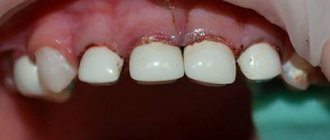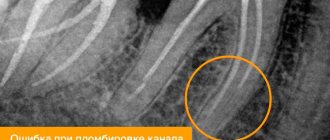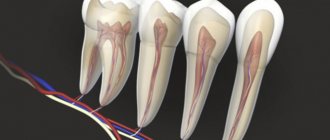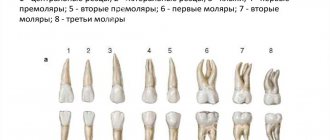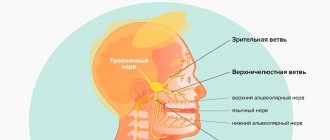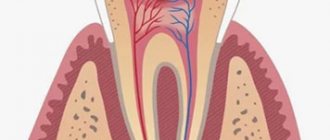The most common diagnosis that gives the dentist the basis for making a decision on depulpation (removal of the dental nerve) is caries in an advanced stage. On tooth enamel, damaged as a result of the spread of carious microorganisms, the nerve is exposed, as a result of which any impact on the tooth becomes not only sensitive, but also extremely painful. The only alternative to implantation is removal of the pulp: complete or partial, depending on the degree of its damage.
What is pulp?
The pulp, or dental nerve, is a bundle of nerve endings and capillaries in the internal cavity of the tooth. It is protected from external irritants and infection by the tissue that is located in the root and crown.
After removal of the nerve, the blood supply and mineralization of the tooth deteriorate significantly. In addition, its sensitivity decreases, the enamel becomes dull and weakens. In other words, pulp removal negatively affects the structure and strength of the tooth, but makes it possible to preserve it.
Indications for the procedure:
- exposure of the nerve as a result of tooth trauma and damage to the crown;
- consequences of improper dental treatment;
- the presence of caries-affected tissues;
- preparation for prosthetics;
- chronic inflammation of the pulp (pulpitis);
- inflammation of the root membrane of the tooth (periodontitis);
- low placement of crowns;
- extensive pulp area;
- bactericidal infection of the apex of the tooth root.
Why does a tooth need a nerve?
The main function of nerve endings is sensory perception. With the rapid development of the pathological process, a pain reaction occurs, which signals tissue damage. Many people ask why there is a nerve in a tooth. In reality, it plays an important role and performs the following functions:
- Sensory. Signals the presence of development of an anomalous process.
- Nutritious. Provides nutrition to soft and hard tooth tissues.
- Immune. Plays an important protective role.
In addition, nerve endings play an important role in the mineralization of enamel and dentin. Why there are nerves in a tooth and what their role is, you can find out from our dentists at the Alpha Dent clinic. They are always ready to clearly demonstrate and tell everything so that the patient has a complete picture of why pain occurs and how to prevent the spread of the inflammatory process. Our clinic specialists are always ready to provide free advice and provide the necessary assistance.
How is the dental nerve removed?
The procedure is carried out in several stages:
- Radiography. It allows you to determine the vitality of the pulp, the length of the canal and the structure of the branches that need to be filled.
- Anesthesia. It can be local or general, depending on the indications and preferences of the patient. In both cases, the depulpation process is absolutely painless. General anesthesia is commonly used to treat children and people suffering from true dental phobia.
- Isolation of the tooth. To prevent bacteria from entering with saliva and at the same time make the doctor’s work easier, a latex film (cofferdam) is installed.
- Removal of the dental nerve. By excision of tissues damaged by caries, access to the pulp is provided, after which its chamber is opened and straight vertical walls are formed. The pulp is pulled out using a pulp extractor. The removal process is not very long. In modern dentistry, special files are more often used, with the help of which they expand the canal and carefully cut off the desired part of the pulp without disturbing areas sensitive to endodontic treatment.
- Installation of a temporary filling (it must be replaced after a maximum of 7 days).
- Control radiography.
- Placing a permanent filling.
Modern method of depulpation
Today, depulpation is carried out using a pulp extractor - a thin metal rod with teeth that can penetrate even remote areas of the root canals. The apex locator device helps determine the depth of the canal to reduce the risk of injury. After the procedure, a temporary filling is usually installed, but a permanent one can also be installed if the doctor does not see the risks of complications and has high-precision instruments on hand, for example, a dental microscope.
Why is it not necessary to remove the nerve to install crowns?
The need to remove the nerve arises primarily when the tooth is completely destroyed. It can also be dictated by the qualifications of the doctor: when heating or deeply removing the top layer, there is a risk of damage to the nerve endings, and this is very painful. That is why many dentists prefer a safer route, that is, preliminary removal of the nerve. Especially in the presence of the initial stage of caries.
In addition, depulpation can be performed in a number of cases before prosthetics: with increased sensitivity, with small sizes and in the presence of more than 15-degree inclination of the teeth. The pulp may also be removed for aesthetic reasons.
It is not necessary to perform depulpation before installing crowns, since the nerve can always be removed through the top of the crown.
After depulpation, the hole is filled. The main disadvantage of this procedure is the exposed tooth root, which can cause complications in the future.
Practical recommendations after visiting the dentist
If depulpation is performed correctly, pain may be observed. The pain may persist for several days. In this case, you can use painkillers prescribed by your dentist. However, if the pain does not stop for a week or more, you should immediately consult a doctor.
In this article, we learned why there are nerve endings in teeth, what important function they perform, and how to act in case of severe pain. In addition, you can learn more about why nerves are needed in teeth on specialized medical web resources, where dentists describe and explain everything in detail.
Alpha Dent specialists provide high-quality dental services. The clinic uses advanced equipment and innovative drugs, which ensures impeccable quality of therapy. Dentists will be happy to tell you how the nerves are located in a person’s teeth and what treatment is needed to achieve the desired result.
Causes of tooth pain after depulpation
Individual reaction of the body
May appear in the first two days. Even after the nerve is removed, the tooth is still able to respond to strong pressure and thermal irritants, but not longer than 3-4 days.
Poor quality of pulp extractors or inability to handle them
Pulp extraction instruments are marked because they must fit the canal.
Poor quality channel cleaning
The presence of tissues damaged by caries will certainly lead to renewed pain and complications of the inflammatory process, so it is extremely important to remove them completely.
Allergic reaction to filling materials
This rarely happens, especially if the doctor has determined in advance the patient’s predisposition to allergies.
Instrument fracture
If the instrument was damaged during the procedure and its remains lingered at the top of the root, they will cause pain. In the worst case, if there is already a filling, the tooth will need to be removed.
Residual pulpitis
May affect one or more canals. The main symptom of such a secondary inflammatory process is aching pain, which then becomes acute. Relapse is possible with partial depulpation.
Is it possible to kill a nerve yourself using traditional methods?
Many people are interested in the question of whether it is possible to kill the pulp on their own at home and what folk remedies are best to use for this. The answer will be categorical: such serious dental procedures should be performed by a professional doctor, and nothing else. Otherwise, you risk only aggravating the situation and provoking the development of serious complications.
Therefore, below, for informational purposes only, are the old methods that were previously popularly used to kill a tooth. Here's what they used to kill the nerve, except for arsenic:
- vinegar - moisten a piece of cotton wool in vinegar essence and apply to the causative tooth. Great care should be taken as the essence quickly corrodes enamel and dentin,
- gunpowder - place the substance into the carious cavity, but under no circumstances swallow it, as this can lead to serious poisoning,
- iodine – moisten a piece of cotton wool with iodine and apply it to the hole. You just have to prepare for the fact that it will hurt very, very badly,
Iodine is also used in folk medicine - zinc - burn a piece of newspaper with black ink, collect the ashes on a cotton swab and place it as close to the nerve as possible, leaving it there for about 12 hours,
- arsenic - place a pea of a toxic substance into a cavity in a tooth. It is very easy to fail to calculate the dosage, which can result in serious poisoning of the body and even death.
Under no circumstances should you try to use these methods on yourself. Contact your dentist and undergo the appropriate procedure under the supervision of an experienced specialist. Independent attempts are fraught with dangerous complications.
Pain Management Options
The duration of action of a standard anesthetic injection is 45 minutes. Patients who are afraid of injections are offered treatment of the depulpation site with a special paste-like composition of a similar effect. Tablet analgesics may reduce the effectiveness of anesthesia, so dentists do not recommend their use.
The dentist chooses the painkiller, as well as the dosage. Since everyone's pain threshold is different, the dose of anesthetic is often doubled or tripled. If the doctor has administered anesthesia according to the protocol, the patient will not feel any pain or discomfort.
What to do if pills don't help
If you still reach this state or the pain arose suddenly (this no longer matters), painkillers do not help in any quantity, look for a way out of the situation. It is better if you still consult a doctor.
When medications do not help, this means that the inflammatory process has reached such an extent that the tooth must be opened immediately. Wild pain, this is how everyone who has experienced it characterizes this condition. Nothing will help here - neither compresses, nor folk remedies, nor tablets. The accumulated pus puts pressure on the tissue, the pain becomes unbearable.
There are 24-hour dental services at night; find the phone number on the Internet, call and arrange a visit. Toothache is dangerous because it completely exhausts a person. You shouldn't bring yourself to this state.
If you think that you can hold out until the morning or until the appointed time, try to distract yourself or apply psychological techniques on yourself. It's better if you are on the move. Some active actions will shift your attention, and you will feel a little better.
If you notice that your medications are no longer working, you should no longer take them. An overdose and an allergic reaction are possible, in which case you will need to call an ambulance.
Possible complications after depulpation
After the procedure, you may experience:
- Canal bleeding. The main reason for this phenomenon is the separation of the pulp by the pulp extractor. To avoid this problem, dentists practice gradual cutting of soft tissue using files and copious rinsing with an antiseptic. Only a doctor can stop canal bleeding.
- Short-term pain. Their duration may vary, but if they do not go away for a long time, it is necessary to re-open the canals and disinfect them.
- The appearance of a cyst, granuloma, gumboil or fistula.
- Facial paralysis. May occur due to improper application of material. If it protrudes beyond the upper part of the root, it will not only affect the tooth, but also compress the nerve of the jaw. That is why if you have pain in the chin area, you should immediately consult a dentist.
If disinfection is of poor quality during pulp removal, there is a risk of suppuration and the development of periodontal abscess. In this case, tooth extraction cannot be avoided.
What is strictly forbidden to do
There are also several strict restrictions and prohibitions that must be observed to avoid unwanted consequences. Here are the main ones:
- you can’t heat the causal area - no hot compresses, which only intensify the pain and provoke the spread of inflammation,
- you should not take a horizontal position - this will increase blood flow to the painful area, which will make the unpleasant sensations even more intense,
- Under no circumstances should you use needles - some try to pick out the cavity themselves, but this is strictly prohibited. Otherwise, you can provoke severe bleeding and even infection.
In no case should you attach a heating pad to an inflamed nerve.
Killing and removing a nerve from a tooth, even in dentistry, is considered a serious procedure that requires the proper experience and dexterity from a specialist. Therefore, in case of inflammation of the pulp, the help of a qualified specialist – an endodontist – is required. This is not a case where you can do it on your own. Don't risk your health.
1According to information at the office. manufacturer's website: vladmiva.ru.
Contraindications for depulpation
Dental pulp cannot be excised if:
- sore throat, flu, ARVI;
- infectious hepatitis;
- any form of stomatitis;
- psychoemotional disorders;
- acute forms of heart and vascular diseases;
- hemorrhagic diathesis;
- acute leukemia;
- inflammation and suppuration in the mouth.
In addition, removal of the dental nerve is contraindicated during pregnancy and lactation.
Professional treatment
Its tactics and volume are determined by the doctor, and it depends on the causes of the problem and the condition of the diseased tooth. After an in-person examination, if necessary, the specialist sends the patient for an x-ray in order to accurately determine the location of the lesion and examine the condition of the root and dental tissues.
Based on a preliminary study, the following assistance can be provided to the patient:
- Treatment of caries;
- Depulpation of the tooth with treatment and subsequent filling of the dental canals;
- If its tissues are severely damaged, it may be necessary to install a crown or other types of prostheses (for example, veneers, lumineers);
- If the cause of the pain lies in a root disease, if possible, it is treated by opening the canals. It is possible that resection of its apex will be required to eliminate the source of inflammation and preserve the tooth;
- In some cases, it is not possible to avoid completely removing the latter.
If discomfort occurs after filling, and the reason lies in improper treatment, the filling is opened, the canals are treated, if necessary, and then the filling is repeated.
What does tooth color change mean after pulp removal?
Nowadays, almost all private dental clinics adhere to international depulpation protocols, but outdated practices are still in use in budgetary medical institutions. The main reasons for tooth discoloration are improper preparation of the cavity for installation of a filling, poor quality of instrumentation of the canal and poor materials for filling. For example, when using endomethasone, the enamel turns yellow (a similar outcome is even prescribed in the instructions). If resorcinol-formalin paste was used for filling, the teeth may turn pink. Most often, this material is used in the treatment of baby teeth.
The nerves from wisdom teeth, which dentists call “problem eights,” are extremely rarely removed. Given their location and short service life, as well as the difficulty of cleaning from stone and plaque, they are easier to remove. As a rule, the figure eight is removed in case of incorrect eruption (if there is a slope towards the tongue or towards the cheek), tooth retention, carious lesions, pulpitis, changes in bite, displacement of the dentition.
After depulpation, you should adhere to the following recommendations:
- Avoid physical activity for the first 2 hours after the procedure.
- To avoid infection and injury to the tooth, do not eat food for 3 hours after pulp removal (you can drink warm water through a straw).
- For 5 days, exclude rough, solid foods from the diet.
- To avoid irritation of the oral mucosa, it is advisable not to smoke, drink alcoholic beverages, or eat spicy, cold or hot foods for at least 5 days.
- Rinse your mouth with antiseptics prescribed by your dentist for at least 1 day.
It is impossible to remove the dental nerve using folk remedies. Even if it can be destroyed, the pulp will need to be removed, and this can only be done with a special medical instrument.
When planning a visit to the dentist, remember that the longer you delay, the more difficult and expensive depulp removal will be. And do not forget that such intervention is recommended only if there are good reasons for it. Any dentist will try his best to keep the tooth “alive” if possible.
How to relieve pain at home yourself
It is worth taking a closer look at the question of how you can calm the nerve yourself before visiting a specialist. You need to understand that such remedies are only needed to mask the symptoms, but they will not help to quickly kill the pulp and relieve you of pain forever. Therefore, you will have to visit the dentist in any case. And if it is not possible to do this urgently, the following traditional medicine recipes will help to relieve the pain and discomfort a little:
- Soda-salt solution is one of the most popular and effective home remedies for relieving acute toothache. A teaspoon of salt and soda should be diluted in a glass of boiled water at room temperature and then used for rinsing the mouth,
You can use a solution of soda and salt - a solution based on 3% hydrogen peroxide also helps reduce the intensity of discomfort. Peroxide should be diluted in warm water in a ratio of 2 to 1, then soak a cotton swab in the resulting solution and apply it to the sore tooth,
- onion peels will help reduce pain and disinfect tissues. To do this, pour 500 ml of boiling water over a small handful of husks and leave for a while on low heat. Strain the finished broth, let it sit for 2-3 hours and then use it for rinsing,
- a mixture of garlic and salt will help reduce inflammation somewhat. To do this, it is placed in an open carious cavity,
- Clove essential oil has pronounced antiseptic and anti-inflammatory properties. It is enough to drop a couple of drops on a cotton swab and cover the painful area with it,
- herbal decoctions of chamomile, mint, lemon balm, thyme, sage and oak bark. You can prepare a decoction of herbal tea or use one type of dried flower.
Herbal decoctions can be used at home
Remember that any attempts to kill the exposed nerve yourself will only lead to a worsening of the condition and the development of dangerous complications. If your tooth hurts badly, try to see a specialist as soon as possible.
How to kill with drugs
The use of the above products requires careful preparation, and then high-quality dental treatment.
The entire process of nerve removal includes the following steps:
- Opening the tooth - it is necessary to fully expose the pulp.
- Application of medication and temporary filling.
- Removing the applied composition, cleaning the canals, if necessary.
- Additional disinfection.
- Filling or other type of treatment.
- Control photo.
If you have severe pain, it is recommended to consult a dentist to identify the causes and develop appropriate treatment. Otherwise, you can only make the situation worse.
How long does it take to die
Killing the nerve is called a devitalization procedure. This relieves periodic pain when eating cold, hot or sweet foods. The nerve dies from a day to several days or even months - it all depends on the method used for this. If a special remedy is used, then you won’t have to wait long - the well-known arsenic neutralizes nerve endings within 24 hours or even less.
If the decision was made not to touch the entire destroyed tooth, then you will have to endure periodic unbearable pain for several months - killing occurs due to developing dangerous bacteria. It is prohibited to resort to such a method, because it is fraught with the formation of a cyst due to the discarded “waste” into the gums and pulp.
This is important: Devitalization involves stopping the nutrition of the tooth, so after some time the crown will darken. The way out of the situation is treatment - the use of a filling will close the exposed roots and gums, and also prevent darkening of the bone part.
How dentists do it
For devitalization, it is better to contact dentists, who will conduct a thorough examination, determining the cause of the toothache. Specialists use special means to quickly kill the nerve and stop the patient’s suffering.
Arsenic pastes
Arsenic is the most common dental nerve killer used in dentistry. Previously, it was used in its “pure” form, mixed with suitable additives.
Today we offer ready-made formulations :
- Devit-ars - promotes rapid neutralization of the nerve, has an analgesic effect due to the content of lidocaine hydrochloride. The mixture is applied for a day, but with a special tooth structure, exposure is required for 2 days.
- Kaustinerv Rapid - the main component in the form of arsenic anhydride is contained in only one third of the presented composition. The rest is lidocaine, menthol, phenol and other additives. As a result, it is used to kill the nerve for 2-3 days.
- Septodont is a paste with a wide range of effects, actively used for the treatment of periodontitis. Has antibacterial and antifungal effects.
- Pulparsen - one third consists of the main substance arsenic, contains the antiseptic camphor.
- Causticin is also one third of arsenic anhydride, the rest is reserved for antiseptic and analgesic substances. Use to neutralize the dental nerve for at least 2 days.
Devit Ars Kaustinerv Septodont
Attention: The use of arsenic-based products must be carried out in strict compliance with the instructions and only with the permission of a doctor. Violation of recommendations may lead to irreversible consequences for human health.
Arsenic-free pastes
Such drugs include Devit-P and Devit-S . These agents are based on paraformaldehyde, lidocaine has an anesthetic effect, and creosote has an antimicrobial effect. Due to the fact that the drugs do not contain arsenic, their use takes place within 10 days.
Devit P Devit S
The advantage of the presented products is the absence of a substance dangerous to the human body and the need to clean the dental canal before treatment.
Process steps
Once the medication is applied to the exposed pulp, the process of neutralizing the dental nerve begins. Due to the influence of basic substances, cell respiration is impaired, resulting in decomposition of the constituent nerve branches.
Watch how a nerve is removed in dentistry:
Preparing for the procedure at home
Self-killing a nerve at home begins with preparation, which takes place in the following sequence :
Brushing your teeth – It is important to thoroughly clean your teeth, especially the one that will be treated. When brushing, all actions are smooth and without pressing with a toothbrush - this can provoke a new attack of pain.
Disinfection of available instruments - applying a paste or other product can be done in different ways using the most unexpected tools. All used items must be disinfected with alcohol or vodka.
Cleaning the hollow of a tooth - take a needle or thin wire and clean with careful and leisurely movements.
Rinsing the tooth with an antiseptic - after all procedures, the oral cavity is simply rinsed with a special antiseptic solution.
After the preparation has been completed, they begin to search for a tooth that has no prospects for treatment. To do this, touch each person with a cooled cotton ball, “listening” to the pain syndrome. If the pain is severe but short-lived, then the tooth should be treated by a dentist. If the pain goes away only after a few minutes, the tooth can be “finished off.”
Causes of pain
Inflammatory diseases in the pulp chamber do not appear without reason. The pathological process develops as a result of certain factors:
- Caries or inflammatory diseases of the soft tissues of the mouth.
- Mechanical damage to the tooth or jaw bones, which exposes the nerve.
- Poorly performed dental treatment.
- Internal problems in the body of an infectious nature.
Signs of nerve inflammation always present with the same clinical picture, regardless of the cause of the problem. At the initial stages of the disease, a person notices an acute reaction of the teeth to temperature, chemical and taste stimuli.
As pulpitis progresses, other symptoms arise:
- bad breath associated with decay of tooth tissue;
- spasms of a pulsating nature, which are difficult to eliminate even with the help of powerful painkillers.
If not treated in a timely manner, pulpitis can develop into gumboil. In this case, there can be no question of saving the dental nerve. The main goal of flux treatment is to prevent further spread of infection in the body.
Why else can a nerve become inflamed? Factors that increase the risk of pulp damage include:
- poor quality or untimely oral care;
- unbalanced diet and predominance of soft foods in the diet;
- lack of preventive visits to the dentist.
